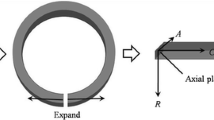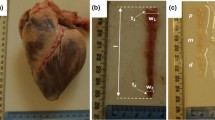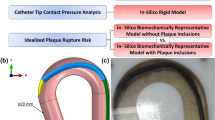Abstract
To identify the orthotropic biomechanical behavior of arteries, researchers typically perform stretch-pressure-inflation tests on tube-form arteries or planar biaxial testing of splayed sections. We examined variations in finite element simulations (FESs) driven from planar or tubular testing of the same coronary arteries to determine what differences exist when picking one testing technique vs. another. Arteries were tested in tube-form first, then tested in planar-form, and fit to a Fung-type strain energy density function. Afterwards, arteries were modeled via finite element analysis looking at stress and displacement behavior in different scenarios (e.g., tube FESs with tube- or planar-driven constitutive models). When performing FESs of tube inflation from a planar-driven constitutive model, pressure–diameter results had an error of 12.3% compared to pressure-inflation data. Circumferential stresses were different between tube- and planar-driven pressure-inflation models by 50.4% with the planar-driven model having higher stresses. This reduced to 3.9% when rolling the sample to a tube first with planar-driven properties, then inflating with tubular-driven properties. Microstructure showed primarily axial orientation in the tubular and opening-angle configurations. There was a shift towards the circumferential direction upon flattening of 8.0°. There was also noticeable collagen uncrimping in the flattened tissue.








Similar content being viewed by others
References
A. H. Association. Heart Disease and Stroke Statistics—2010 Update. Dallas, TX: American Heart Association, 2010.
Bund, S. J. Spontaneously hypertensive rat resistance artery structure related to myogenic and mechanical properties. Clin. Sci. (Lond.) 101(4):385–393, 2001.
Carson, F. L. Histotechnology: A Self-Instructional Text (2nd ed.). Chicago: ASCP Press, 2007.
Chesler, N. C., J. Thompson-Figueroa, and K. Millburne. Measurements of mouse pulmonary artery biomechanics. J. Biomech. Eng. 126(2):309–314, 2004.
Chow, M. J., and Y. Zhang. Changes in the mechanical and biochemical properties of aortic tissue due to cold storage. J. Surg. Res. 171(2):434–442, 2011.
Chuong, C. J., and Y. C. Fung. Compressibility and constitutive equation of arterial wall in radial compression experiments. J. Biomech. 17(1):35–40, 1984.
Chuong, C. J., and Y. C. Fung. On residual stresses in arteries. J. Biomech. Eng. 108(2):189–192, 1986.
Crick, S. J., M. N. Sheppard, S. Y. Ho, L. Gebstein, and R. H. Anderson. Anatomy of the pig heart: comparisons with normal human cardiac structure. J. Anat. 193(Pt 1):105–119, 1998.
D’Amore, A., J. A. Stella, W. R. Wagner, and M. S. Sacks. Characterization of the complete fiber network topology of planar fibrous tissues and scaffolds. Biomaterials 31(20):5345–5354, 2010.
Di Martino, E. S., A. Bohra, J. P. Vande Geest, N. Gupta, M. S. Makaroun, and D. A. Vorp. Biomechanical properties of ruptured versus electively repaired abdominal aortic aneurysm wall tissue. J. Vasc. Surg. 43(3):570–576, 2006. Official publication, the Society for Vascular Surgery [and] International Society for Cardiovascular Surgery, North American Chapter; discussion 576.
Dye, W. W., R. L. Gleason, E. Wilson, and J. D. Humphrey. Altered biomechanical properties of carotid arteries in two mouse models of muscular dystrophy. J. Appl. Physiol. 103(2):664–672, 2007.
Fung, Y. Biomechanics: Mechanical Properties of Living Tissues (2nd ed.). New York: Springer, 1993.
Fung, Y. C., and S. Q. Liu. Determination of the mechanical properties of the different layers of blood vessels in vivo. Proc. Natl. Acad. Sci. USA 92(6):2169–2173, 1995.
Fung, Y. C., and S. Q. Liu. Strain distribution in small blood vessels with zero-stress state taken into consideration. Am. J. Physiol. 262(2 Pt 2):H544–H552, 1992.
Hansen, L., W. Wan, and R. L. Gleason. Microstructurally motivated constitutive modeling of mouse arteries cultured under altered axial stretch. J. Biomech. Eng. 131(10):101015, 2009.
Haskett, D., G. Johnson, A. Zhou, U. Utzinger, and J. Vande Geest. Microstructural and biomechanical alterations of the human aorta as a function of age and location. Biomech. Model Mechanobiol. 9(6):725–736, 2010.
Haskett, D., E. Speicher, M. Fouts, D. Larson, M. Azhar, U. Utzinger, and J. Vande Geest. The effects of angiotensin II on the coupled microstructural and biomechanical response of C57BL/6 mouse aorta. J. Biomech. 45(5):772–779, 2011.
Holzapfel, G. A., G. Sommer, C. T. Gasser, and P. Regitnig. Determination of layer-specific mechanical properties of human coronary arteries with nonatherosclerotic intimal thickening and related constitutive modeling. Am. J. Physiol. Heart Circ. Physiol. 289(5):H2048–H2058, 2005.
Holzapfel, G. A., and H. W. Weizsacker. Biomechanical behavior of the arterial wall and its numerical characterization. Comput. Biol. Med. 28(4):377–392, 1998.
Hughes, G. C., M. J. Post, M. Simons, and B. H. Annex. Translational physiology: porcine models of human coronary artery disease: implications for preclinical trials of therapeutic angiogenesis. J. Appl. Physiol. 94(5):1689–1701, 2003.
Humphrey, J. D., D. L. Vawter, and R. P. Vito. Quantification of strains in biaxially tested soft tissues. J. Biomech. 20(1):59–65, 1987.
John, L. C. Biomechanics of coronary artery and bypass graft disease: potential new approaches. Ann. Thorac. Surg. 87(1):331–338, 2009.
Keyes, J. T., S. M. Borowicz, J. H. Rader, U. Utzinger, M. Azhar, and J. P. Vande Geest. Design and demonstration of a microbiaxial optomechanical device for multiscale characterization of soft biological tissues with two-photon microscopy. Microsc. Microanal. 17(2):167–175, 2011.
Keyes, J. T., D. G. Haskett, U. Utzinger, M. Azhar, and J. P. Vande Geest. Adaptation of a planar microbiaxial optomechanical device for the tubular biaxial microstructural and macroscopic characterization of small vascular tissues. J. Biomech. Eng. 133(7):075001, 2011.
Kim, J., and S. Baek. Circumferential variations of mechanical behavior of the porcine thoracic aorta during the inflation test. J. Biomech. 44(10):1941–1947, 2011.
Kirkpatrick, N. D., S. Andreou, J. B. Hoying, and U. Utzinger. Live imaging of collagen remodeling during angiogenesis. Am. J. Physiol. Heart Circ. Physiol. 292(6):H3198–H3206, 2007.
Lally, C., A. J. Reid, and P. J. Prendergast. Elastic behavior of porcine coronary artery tissue under uniaxial and equibiaxial tension. Ann. Biomed. Eng. 32(10):1355–1364, 2004.
Loree, H. M., B. J. Tobias, L. J. Gibson, R. D. Kamm, D. M. Small, and R. T. Lee. Mechanical properties of model atherosclerotic lesion lipid pools. Arterioscler. Thromb. 14(2):230–234, 1994.
McVeigh, G. E., P. K. Hamilton, and D. R. Morgan. Evaluation of mechanical arterial properties: clinical, experimental and therapeutic aspects. Clin. Sci. (Lond.) 102(1):51–67, 2002.
Miroslave Zemanek, J. B., and M. Detak. Biaxial tension tests with soft tissues of arterial wall. Eng. Mech. 16(1):8, 2009.
Moore, Jr., J. E. Biomechanical issues in endovascular device design. J. Endovasc. Ther. 16(Suppl 1):I1–I11, 2009.
Peterson, S. J., and R. J. Okamoto. Effect of residual stress and heterogeneity on circumferential stress in the arterial wall. J. Biomech. Eng. 122(4):454–456, 2000.
Rachev, A., and S. E. Greenwald. Residual strains in conduit arteries. J. Biomech. 36(5):661–670, 2003.
Raghavan, M. L., S. Trivedi, A. Nagaraj, D. D. McPherson, and K. B. Chandran. Three-dimensional finite element analysis of residual stress in arteries. Ann. Biomed. Eng. 32(2):257–263, 2004.
Sato, M., K. Hayashi, H. Niimi, H. Handa, K. Moritake, and A. Okumura. Mechanical behaviors of arterial walls in the axial direction (author’s transl). Iyodenshi To Seitai Kogaku 15(6):403–409, 1977.
Sato, M., K. Hayashi, H. Niimi, K. Moritake, A. Okumura, and H. Handa. Axial mechanical properties of arterial walls and their anisotropy. Med. Biol. Eng. Comput. 17(2):170–176, 1979.
Skwarek, M., M. Grzybiak, A. Kosinski, and J. Hreczecha. Basic axes of human heart in correlation with heart mass and right ventricular wall thickness. Folia Morphol. 65(4):385–389, 2006.
Swindle, M. M., P. J. Horneffer, T. J. Gardner, V. L. Gott, T. S. Hall, R. S. Stuart, W. A. Baumgartner, A. M. Borkon, E. Galloway, and B. A. Reitz. Anatomic and anesthetic considerations in experimental cardiopulmonary surgery in swine. Lab. Anim. Sci. 36(4):357–361, 1986.
Vaishnav, R. N., and J. Vossoughi. Residual stress and strain in aortic segments. J. Biomech. 20(3):235–239, 1987.
Vande Geest, J. P., M. S. Sacks, and D. A. Vorp. Age dependency of the biaxial biomechanical behavior of human abdominal aorta. J. Biomech. Eng. 126(6):815–822, 2004.
Vande Geest, J. P., M. S. Sacks, and D. A. Vorp. The effects of aneurysm on the biaxial mechanical behavior of human abdominal aorta. J. Biomech. 39(7):1324–1334, 2006.
Vande Geest, J. P., M. S. Sacks, and D. A. Vorp. A planar biaxial constitutive relation for the luminal layer of intra-luminal thrombus in abdominal aortic aneurysms. J. Biomech. 39(13):2347–2354, 2006.
Vossoughi, J. Longitudinal residual strain in arteries. Southern Biomedical Engineering Conference. Memphis, Tennessee; 1992:17–19.
Walden, R., G. J. L’Italien, J. Megerman, and W. M. Abbott. Matched elastic properties and successful arterial grafting. Arch. Surg. 115(10):1166–1169, 1980.
Wan, W., H. Yanagisawa, and R. L. Gleason, Jr. Biomechanical and microstructural properties of common carotid arteries from fibulin-5 null mice. Ann. Biomed. Eng. 38(12):3605–3617, 2010.
Wang, R., and R. L. Gleason, Jr. A mechanical analysis of conduit arteries accounting for longitudinal residual strains. Ann. Biomed. Eng. 38(4):1377–1387, 2010.
Williams, M. J., R. A. Stewart, C. J. Low, and G. T. Wilkins. Assessment of the mechanical properties of coronary arteries using intravascular ultrasound: an in vivo study. Int. J. Card. Imaging 15(4):287–294, 1999.
Wuyts, F. L., V. J. Vanhuyse, G. J. Langewouters, W. F. Decraemer, E. R. Raman, and S. Buyle. Elastic properties of human aortas in relation to age and atherosclerosis: a structural model. Phys. Med. Biol. 40(10):1577–1597, 1995.
Zhang, W., C. Wang, and G. S. Kassab. The mathematical formulation of a generalized Hooke’s law for blood vessels. Biomaterials 28(24):3569–3578, 2007.
Zhao, J., J. Day, Z. F. Yuan, and H. Gregersen. Regional arterial stress-strain distributions referenced to the zero-stress state in the rat. Am. J. Physiol. Heart Circ. Physiol. 282(2):H622–H629, 2002.
Acknowledgments
The authors would like to thank the University of Arizona Meat Sciences Laboratory for help in sample acquisition. The Advanced Intravital Microscope was funded through a NIH/NCRR 1S10RR023737-01. This work is supported, in parts, by the National Institutes of Health Cardiovascular Biomedical Engineering Training Grant (T32 HL007955), an American Heart Association (AHA) Predoctoral Fellowship (11PRE7730024 to JTK), Achievement Rewards for College Scientists (ARCS; Mary Ann White Memorial Scholarship to JTK), an AHA Beginning Grant-in-Aid (0860058Z to JPVG), and an AHA Grant-in-Aid (10GRNT4580045 to JPVG).
Conflict of Interest
The authors have no conflicts of interest to declare.
Author information
Authors and Affiliations
Corresponding author
Additional information
Associate Editor Elena S. Di Martino oversaw the review of this article.
Rights and permissions
About this article
Cite this article
Keyes, J.T., Lockwood, D.R., Utzinger, U. et al. Comparisons of Planar and Tubular Biaxial Tensile Testing Protocols of the Same Porcine Coronary Arteries. Ann Biomed Eng 41, 1579–1591 (2013). https://doi.org/10.1007/s10439-012-0679-0
Received:
Accepted:
Published:
Issue Date:
DOI: https://doi.org/10.1007/s10439-012-0679-0




